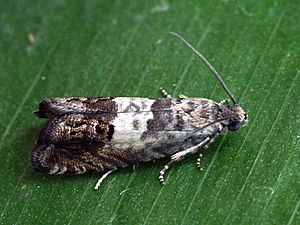Cydia succedana facts for kids
Quick facts for kids Cydia succedana |
|
|---|---|
 |
|
| Cydia succedana Moscow Oblast | |
| Scientific classification | |
| Genus: |
Cydia
|
| Species: |
succedana
|
The Cydia succedana is a small insect also known as the Gorse Pod Moth. It is a type of moth that belongs to the Tortricidae family. These moths are native to Europe. They have also been brought to New Zealand.
Contents
About the Gorse Pod Moth
The Gorse Pod Moth is a fascinating insect. It plays a special role in nature. This moth is known for its unique appearance and its life cycle.
What Does It Look Like?
The Gorse Pod Moth is quite small. Its wings can spread between 11 and 16 millimeters wide. That's about half an inch! The front wings have a white band across them. This band might not reach the very edge of the wing. You might also see some white spots along the wing's front edge. There are also shiny, silver lines near the wing tips. It can be hard to tell this moth apart from a similar species, Cydia albipicta, just by looking at them.
Where Does It Live?
This moth is found across many parts of Europe. It was later introduced to New Zealand. This means people brought it there. The moths fly during the warmer months. You can usually see them from April to September. The exact time depends on where they live.
What Do Its Babies Eat?
The young moths are called larvae. They are like caterpillars. These larvae love to eat certain plants. Their favorite foods include gorse (Ulex europaeus), Genista, Lotus, and Cytisus scoparius.
Moths Helping Plants
In New Zealand, the Gorse Pod Moth larvae are very helpful. They are used for something called biological control. This means using one living thing to control another. Gorse is a plant that can grow too much in New Zealand. It can become a problem. The moth larvae help by eating the seeds of the gorse plant. This stops too much gorse from growing. It's a natural way to manage the plant.

